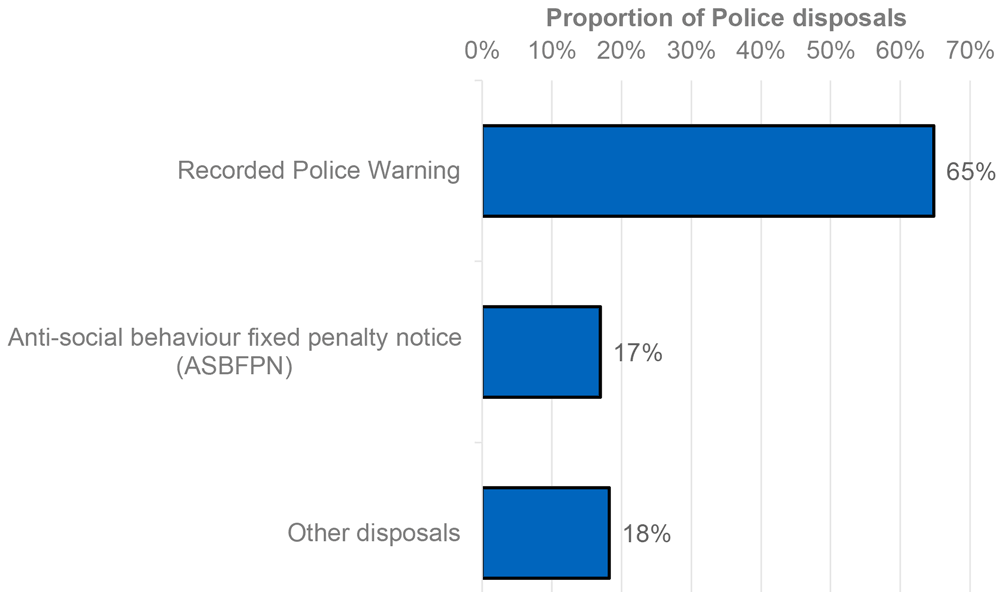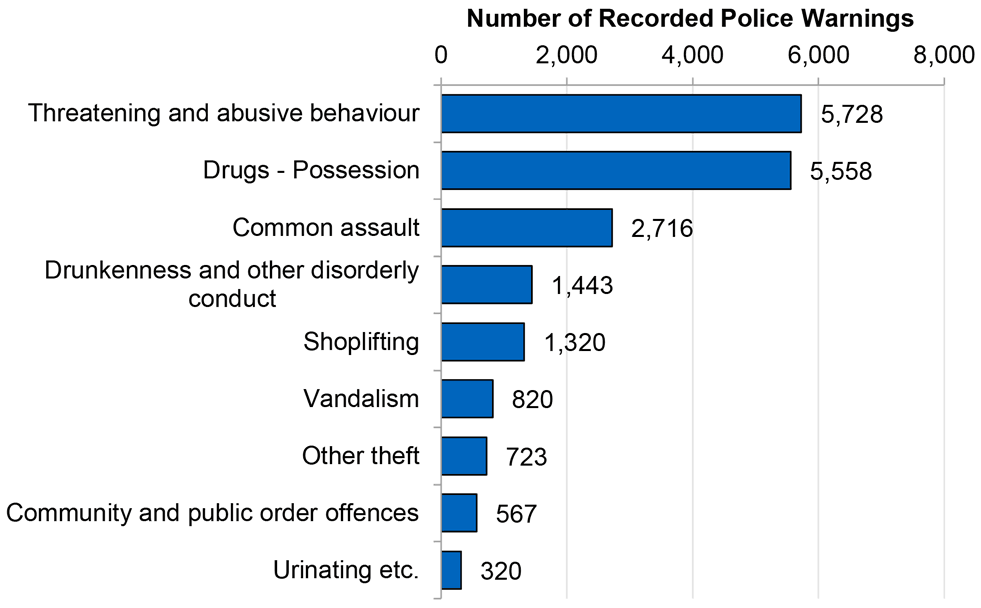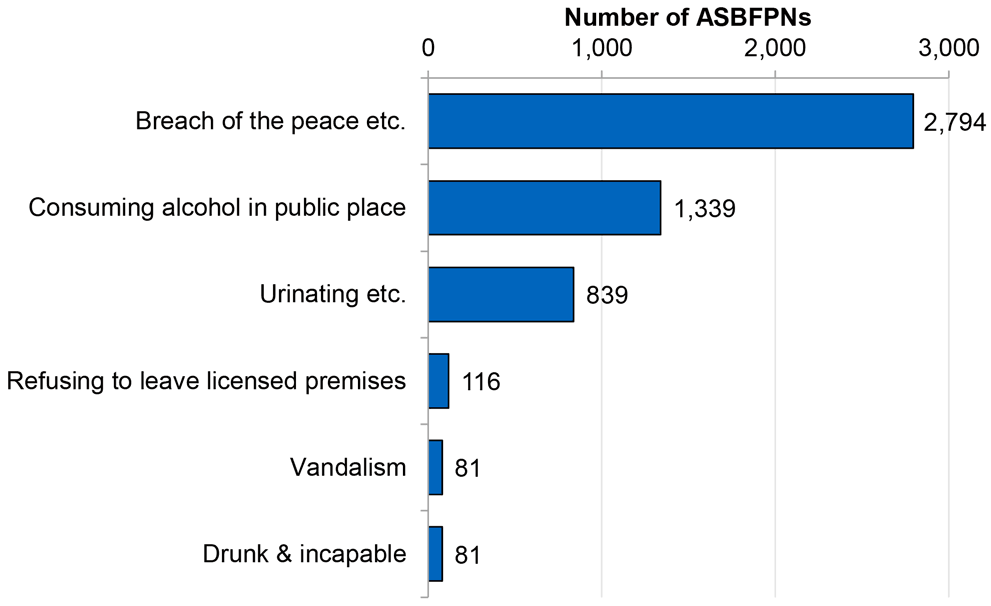Criminal Proceedings in Scotland, 2021-22
Statistics on criminal proceedings concluded in Scottish courts and alternative measures to prosecution issued by the police and the Crown Office and Procurator Fiscal Service are presented for the 10 years from 2012-13 to 2021-22. The latest two years of data were impacted by the COVID-19 pandemic.
This document is part of a collection
15. Police disposals
(Tables 16-19)
This section outlines detail on some of the measures available to the police for dealing with minor offences rather than referring individuals to the Crown Office and Procurator Fiscal Service (COPFS) and therefore potentially to court. Statistics are presented on Recorded Police Warnings (RPWs), Anti-Social Behaviour Fixed Penalty Notices (ASBFPNs) and actions used specifically for juveniles (aged 8 to 17) such as Restorative Justice Warnings and Early and Effective Interventions (EEI). Formal Adult Warnings were phased out following the introduction of RPWs in January 2016.
Police disposals have generally decreased since a peak in the most recent 10 years of 68,289 in 2013-14. The number in 2021-22 was 31,247, which is 2% higher than 2020-21 (30,616).

ASBFPNs accounted for more than 80% of the police disposals presented in this publication in 2013-14, but the number has been declining since then. In 2021-22 they made up 17% of police disposals. The most used police disposal in 2021-22 (65%) was the Recorded Police Warning which was introduced in 2015-16 (Chart 14). It is important to note, however, that there are other types of police measures not included in these statistics such as Fixed Penalty Notices for coronavirus restrictions, moving road traffic offences and other youth justice measures. A more detailed listing of the disposals available in this publication can be seen in Annex D.
Recorded Police Warnings
The use of Recorded Police Warnings (RPWs) grew quickly after their introduction in January 2016, becoming the most used police disposal in 2016-17 (19,678 issued). In 2021-22 there were 20,245 RPWs issued, which is a decrease of 4% from 21,040 in 2020-21.
RPWs were issued in 2021-22 for a wide range of offences, such as Drugs possession (27% of all RPWs) and Threatening and abusive behaviour (28% of all RPWs) (Chart 15). Males received 72% of all RPWs in 2021-22.

The introduction of RPWs coincided with the phasing out of Formal Adult Warnings (FAWs), although FAWs are not a direct replacement for RPWs. Only six FAWs were recorded in 2021-22, and they are expected to disappear completely in the near future.
From 16 July 2018, it became possible to issue RPWs for less serious, non-sexual Common assault, and this use made up 13% of the total number of RPWs in 2021-22.
Anti-Social Behaviour Fixed Penalty Notices
Anti-Social Behaviour Fixed Penalty Notices (ASBFPNs) allow the police to issue offenders a £50 fine for a range of offences including drunken-related behaviours and playing loud music. In 2021-22, 5,301 people received an ASBFPN as a main penalty, an increase of 3% from 5,168 in 2020-21. Between 2013-14 and 2019-20 levels decreased year on year. Some of the decline may be due to Police Scotland issuing revised guidance around the use of ASBFPNs, and there may also be some displacement by the use of Recorded Police Warnings.
In 2021-22 the vast majority of ASBFPNs were issued for three offence types (Chart 16):
- 2,794 for Breach of the peace etc. (53% of ASBFPNs);
- 1,339 for Consuming alcohol in a public place (25% of ASBFPNs); and
- 839 for Urinating etc (16% of ASBFPNs).

Males received 84% of all ASBFPNs in 2021-22 (4,427 people) with the most common offences being for Breach of the peace etc. (49% of ASBFPNs issued to males) followed by Consuming alcohol in public place (27%). ASBFPNs issued to females (874 people in total) were primarily issued for Breach of the peace etc. (70% of ASBFPNs to females) and Consuming alcohol in a public place (19%).
Police disposals for children and young people involved in offending
This section provides statistics on some of the police disposals that specifically target children and young people, under the age of 18, involved in offending. The disposals we have information for are Early and Effective Interventions (EEIs) and Restorative Justice Warnings as recorded on the Criminal History System (CHS).
Please note that these statistics are not a full measure of disposals for under-18s as there are a number of other measures managed by the police and other public bodies that we cannot quantify levels for.
There are a number of routes for dealing with young people who have offended in Scotland as follows:
- The Whole System Approach (WSA) is increasingly used to deal with young people aged 8 to 17. Following the preventing offending framework in 2008 and a WSA pilot in 2010, this approach was rolled out across Scotland in 2011 to encourage justice partners to channel young people away from the adult courts and hearing system. One approach used by the police to respond to the needs of children who offend is Early and Effective Intervention (EEI). Early and Effective Intervention is a multi-agency response to low level offending, typically offences of a less serious nature, which might previously have automatically resulted in referral to the Children’s Reporter. The EEI process runs differently in each Local Authority and the involvement of the police can be different in each Local Authority. For these reasons, the statistics presented here should be seen as a minimum indication of EEI activity.
- Other young people are referred to the Scottish Children’s Reporter Administration (SCRA), which manages the Children’s Hearing system. This is a needs based system, including responding to occasions when children offend, rather than exposing them to the adult courts, which can be a damaging experience. The police can use a number of ways to refer individuals to SCRA such as restorative justice warnings, the disposal for which statistics are available. It is important to note that other organisations such as COPFS, social work and educational bodies can also make referrals to SCRA, though such referrals are not included in the statistics in this report, more information is available in the SCRA Official Statistics.
- Depending on their age and the nature of the offence some young people who have offended move through the Criminal Justice System in the same way as adults i.e. they are issued a disposal by the police, COPFS or the adult courts. This tends to happen for young people accused of more serious crimes with activity for these cases included within the statistics elsewhere in the report. No one under the age of 12 can be prosecuted in the adult courts in Scotland.
- The focus of EEIs is to respond as quickly as possible to offending behaviour by children and young people and to put in place appropriate support with the aim of reducing the likelihood of reoffending. Practices vary by local authority with a range of agencies (police, education, social work and the third sector) being involved.
Trends in police disposals for young people
In terms of police disposals specifically aimed at young people involved in offending, Restorative Justice Warnings have been in decline over the longer term, falling from 621 people in 2012-13 to 330 people in 2019-20. In 2021-22 the number increased to 264 people (up 62% from 163 in 2020-21).
By contrast, the number of young people referred for EEI has increased steadily since their introduction, rising to 6,655 in 2015-16 as the use of these practices became more commonplace. Since then, numbers have fluctuated. In 2021-22, the total number increased by 30% to 5,367 from 4,133 in 2020-21.
Contact
Email: Justice_Analysts@gov.scot
There is a problem
Thanks for your feedback